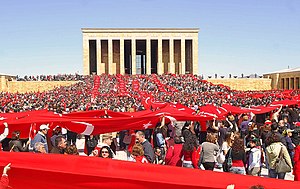Anıtkabir
 |
|
| Coordinates | 39°55′32″N 32°50′15″E / 39.92556°N 32.83750°ECoordinates: 39°55′32″N 32°50′15″E / 39.92556°N 32.83750°E |
|---|---|
| Location | Ankara, Turkey |
| Designer | Emin Halid Onat and Ahmet Orhan Arda |
| Type | Mausoleum |
| Material | Concrete, travertine and marble |
| Length | 57.35 m (188.2 ft) |
| Width | 41.65 m (136.6 ft) |
| Height | 27 m (89 ft) |
| Beginning date | 9 October 1944 |
| Completion date | 1 September 1953 |
| Opening date | 1 September 1953 |
| Dedicated to | Mustafa Kemal Atatürk |
Anıtkabir (literally, "memorial tomb") is the mausoleum of Mustafa Kemal Atatürk, the leader of the Turkish War of Independence and the founder and first President of the Republic of Turkey. It is located in Ankara and was designed by architects Professor Emin Onat and Assistant Professor Ahmet Orhan Arda, whose proposal beat 48 other entries from several countries in a competition held by the Turkish Government in 1941 for a "monumental tomb" for Atatürk.
The site is also the final resting place of İsmet İnönü, the second President of Turkey, who was interred there after he died in 1973. His tomb faces the Atatürk Mausoleum, on the opposite side of the Ceremonial Ground.
The mausoleum was depicted on various Turkish banknotes during 1966–1987 and 1997–2009.
On 10 November 2007, the 69th anniversary of Atatürk's death, 546,620 people, of whom 2,420 were foreigners, visited Anıtkabir, setting an all-time high record of daily visitors. In the first 11 months of 2007, Anıtkabir received more than 11 million visitors, surpassing the total number of visitors for any previous whole year. In 2006, a total of 8,150,000 people and in 2005, a total of 3,800,000 people visited Anıtkabir.
On 10 November 2013, 1,089,615 people visited Anıtkabir which is the new all-time record. On 29 October 2013 which is the anniversary of foundation of Republic of Turkey, 438,451 people visited Anıtkabir, which is also significant amount of visitors for only one day. On 10 November 2012, the recorded number of visitors are announced as 413,568 people.
The period of Turkish architecture between 1940 and 1950 has been classified by architectural historians as the Second National Architecture Movement. This period is characterized mostly by monumental, symmetrical, cut-stone clad buildings, with great emphasis given to detailing and workmanship in construction. Anıtkabir contains the same characteristics of this period, and is considered by many to be the ultimate monument of the era. In addition, Anıtkabir features Seljuq and Ottoman architectural and ornamentation features. For example, the eaves of the towers and the Hall of Honour are all Seljuq-style sawtooth ornamentation.
...
Wikipedia
